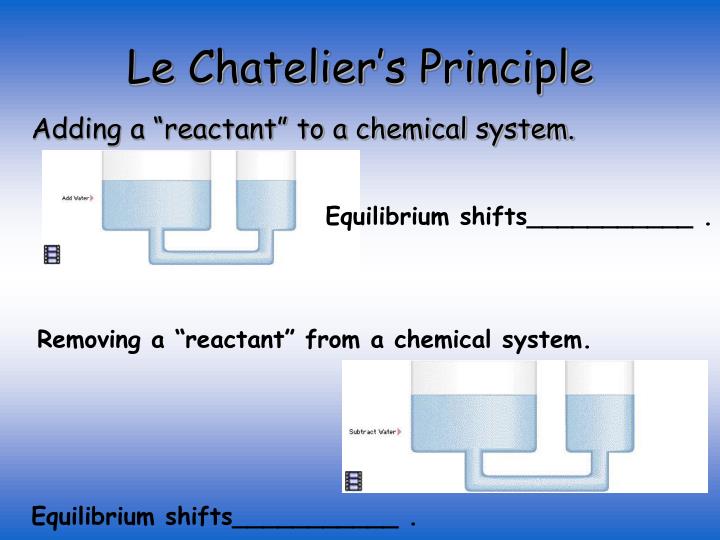
Here are some examples of its applications in various industrial processes. Le Chatelier’s Principle is widely used in the chemical industry to optimize industrial processes and maximize the production of desired products. Industrial Applications of Le Chatlier’s Principle The equilibrium will return to its original position if the reaction is allowed to continue and the number of moles grows. When applied, they have an impact comparable to a shift in pressure. It is possible that variations in volume might impact the equilibrium of a chemical reaction involving a gas. This is because increasing the concentration of one of the reactants increases the rate of the forward reaction, and shifting the equilibrium to the right helps to consume the excess reactant.

In this case, the reaction will shift to the right, meaning that more products will be formed. If we increase one of the reactant concentrations, the equilibrium will change to compensate. This is because decreasing the pressure reduces the number of gas molecules present, and shifting the equilibrium to the left helps to increase the number of gas molecules. Since there are four moles of gas on the left side of the equation and only two on the right side, The response will go to the left, resulting in more nitrogen and hydrogen and less ammonia. In this case, the reaction will shift to the side with more moles of gas. Similarly, if we lower the system’s pressure, the equilibrium will shift to accommodate the reduction. By shifting the equilibrium to the left, the system will absorb the excess heat, which helps to counteract the increase in temperature. This is because the reaction is exothermic, and the forward reaction releases heat. In this case, the reaction will shift to the left, meaning that more nitrogen and hydrogen will be present, and less ammonia will be formed. The outcome of a chemical reaction depends on whether it is endothermic or exothermic.Īccording to Le Chatelier’s Principle, if we increase the temperature of the system, the equilibrium will shift to account for the different circumstances. The chemical balance may be upset by other means as well, for as by changing the temperature. That is to say, if something disrupts a system’s equilibrium, it will move towards a new position that minimizes the effect of the disruption. When a change is introduced into a system that is otherwise in equilibrium, the system will readjust its position in the equilibrium state to account for the disruption. Le Chatelier’s Principle is a useful tool for understanding and predicting the behaviour of chemical reactions and is widely used in the chemical process industry.

Virtually all chemical reactions are accompanied by the liberation or uptake of heat.Le Chatelier’s Principle, named after French chemist Henri Louis Le Chatelier, states that when a system at equilibrium is subjected to a change in conditions (such as temperature, pressure, concentration, or volume), the system will adjust its equilibrium position in a way that counteracts the change in conditions. How do changes in temperature affect Equilibria? Catalysts affect only the rate of a reaction the have no effect at all on the composition of the equilibrium state. This is known as the common ion effect on solubility.Ī catalyst is added to speed up this reaction Shift to left due to increase in Cl – concentration.

Shift to right the product diminishes more rapidly than does.

This is the basis for the commercial production of hydrochloric acid.Ĭontinuous removal of water vapor forces the reaction to the right, so equilibrium is never achieved. Reaction is carried out in an open containerīecause HCl is a gas that can escape from the system, the reaction is forced to the right. No change N 2 is not a component of this reaction system. Continuous removal of a product will force any reaction to the right \): Example of Le Chatelier's principle CO 2 + H 2 → H 2O (g) + CO


 0 kommentar(er)
0 kommentar(er)
